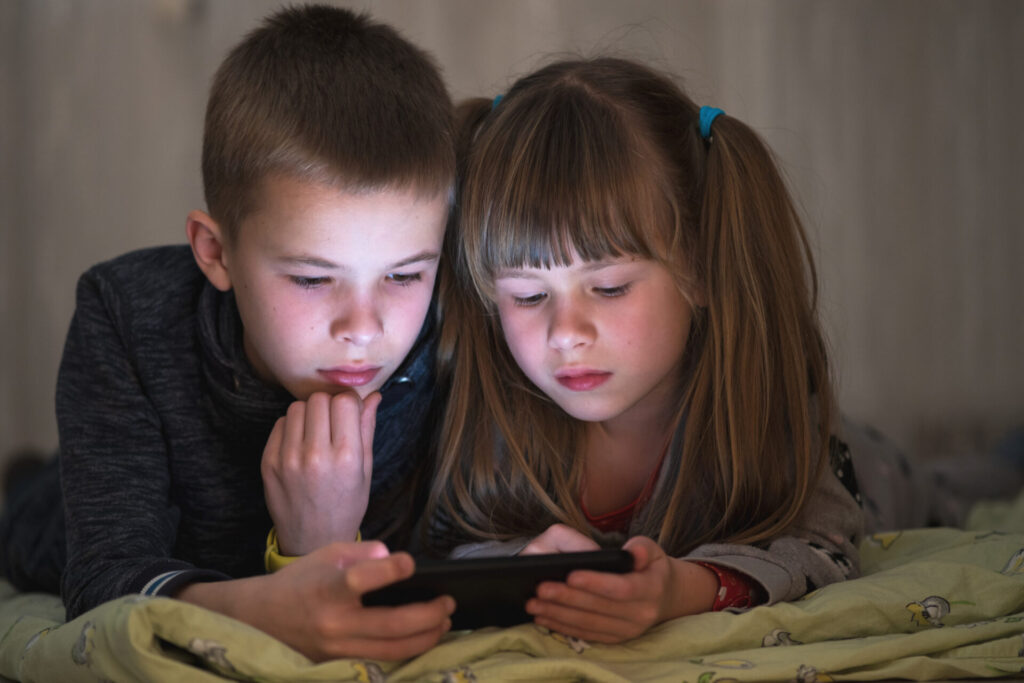Why Screen Time Guidelines Matter More Than Ever
In today’s digital-first world, screen time is no longer a luxury — it’s a daily norm. From online learning to entertainment, children are growing up with screens as a constant presence. While technology opens doors to knowledge and creativity, the lack of structure around its use can quietly reshape a child’s behavior, development, and even relationships.
It’s no surprise that more parents are searching for clear, evidence-based screen time recommendations for kids — guidance that doesn’t demonize technology, but instead helps families make healthier decisions.
The Problem Isn’t Screens — It’s the Overuse
Not all screen time is harmful. In fact, educational content, interactive tools, and virtual learning can support cognitive development when used in moderation. The real challenge? Too much passive or unmonitored screen time.
Excessive screen use has been linked to:
- 📉 Declines in attention span and sleep quality
- 🧠 Delayed emotional and social development
- ⚠️ Increased risks of anxiety, digital addiction, and behavioral issues
- 📺 Replacing outdoor play, reading, and face-to-face interaction
Understanding the effects of screen time on child development is essential for any parent striving to raise well-rounded, emotionally resilient kids.
Families Need a Clear, Age-Appropriate Plan
The solution isn’t to eliminate technology — it’s to set realistic, age-appropriate boundaries and teach children to use screens intentionally and mindfully.
That’s where this guide comes in. You’ll find:
✔️ Practical tips for setting healthy screen time limits
✔️ A breakdown of recommendations by age group
✔️ Smart ways to balance tech with offline activities
✔️ Tools for creating healthy screen habits for the whole family
If you’ve been searching for answers on how to limit screen time for children without conflict, confusion, or guilt — you’re in the right place. This article will help you move from frustration to confidence in managing digital life at home.
“Don’t aim to control screens. Teach your child to control their attention.”
Let’s explore the smart, science-backed strategies that can make screen time a positive force in your child’s life — not a problem to fear.
Understanding the Impact of Screen Time
Physical and Mental Health Effects
Excessive screen time is linked to various health concerns in children, affecting both their physical and mental well-being.
Physical Health Risks
➡️ Obesity – Prolonged screen use promotes a sedentary lifestyle, reducing physical activity. Studies show that children who spend more than two hours per day on screens have a higher risk of obesity due to reduced movement and increased snacking.
➡️ Sleep Disruptions – Blue light emitted by screens suppresses melatonin, the hormone responsible for sleep regulation. Kids who use screens before bed tend to fall asleep later and sleep less than those with limited evening screen exposure.
➡️ Eye Strain & Headaches – Staring at screens for long periods can lead to digital eye strain (also called Computer Vision Syndrome), causing dry eyes, blurred vision, and headaches.
➡️ Posture Problems – Poor posture while using devices can contribute to neck and back pain, often referred to as “tech neck.”
Mental Health & Emotional Well-Being
🚨 Increased Anxiety & Depression – Social media overuse, online bullying, and exposure to unrealistic beauty standards contribute to lower self-esteem and increased anxiety and depression in children and teens.
🚨 Reduced Attention Span – Fast-paced digital content, particularly from social media and gaming, conditions the brain for constant stimulation, making it harder for kids to focus on schoolwork or offline activities.
🚨 Addiction-Like Behaviors – Dopamine release from likes, comments, and gaming rewards can create an addictive loop, making it difficult for kids to self-regulate screen time.
Cognitive and Behavioral Development
📉 Delayed Language & Social Skills – Studies show that toddlers who spend excessive time on screens may have slower language development and weaker social skills, as they miss crucial face-to-face interactions.
📉 Lower Academic Performance – While educational apps and videos can be beneficial, unregulated screen use can lead to poor time management, impacting homework and study habits.
📉 Impulsive Behavior & Emotional Outbursts – Children who play fast-paced video games or consume excessive digital content may struggle with self-control, experiencing frustration and impatience in real-world situations.
📌 Key Takeaway: Managing screen time isn’t just about limiting exposure—it’s about ensuring that digital consumption supports healthy growth rather than hindering it.

Setting Healthy Screen Time Limits
Age-Appropriate Screen Time Guidelines
Not all screen time is harmful, but it must be age-appropriate and balanced with physical, social, and educational activities. Below are the recommended screen time limits by the American Academy of Pediatrics (AAP):
| Age Group | Recommended Screen Time |
|---|---|
| 0–18 months | ❌ No screen time, except for video calls. |
| 18–24 months | ✅ Limited high-quality content with parental co-viewing. |
| 2–5 years | ⏳ Max 1 hour/day of educational screen time. |
| 6–12 years | ⏳ 1–2 hours/day, balancing with offline activities. |
| 13–18 years | 🔄 Varies based on schoolwork, social interaction, and hobbies, but should not interfere with sleep, exercise, or personal connections. |
The Balance Between Online and Offline Activitiess
❗ Balance is key – Rather than completely banning screens, parents should help children integrate healthy tech habits into their daily routines. Here’s how:
✔️ Prioritize Essential Activities First – Ensure kids complete homework, engage in physical activity, and have social interactions before screen use.
✔️ Encourage Offline Hobbies – Promote activities like reading, drawing, sports, music, and board games to reduce digital dependency.
✔️ Screen-Free Mealtimes & Bedrooms – Keeping screens out of the dining area and bedrooms helps improve sleep quality and family bonding.
✔️ Set Device-Free Hours – Designate specific times for unplugged activities, such as family outings or outdoor play.
The Importance of Parental Modeling
Kids learn by observing their parents. If parents are constantly on their phones, children will follow suit.
👨👩👧 How to Set a Good Example:
🔹 Limit Your Own Screen Time – Be mindful of how much time you spend on your phone or laptop.
🔹 Engage in Family Activities – Encourage face-to-face conversations, shared meals, and outdoor play.
🔹 Demonstrate Healthy Tech Use – Show kids that screens can be used for learning, creativity, and productivity rather than just passive entertainment.
📌 Key Takeaway: Setting screen time limits works best when paired with structured routines, engaging offline activities, and strong parental role modeling.

Practical Strategies for Reducing Screen Time
Creating a Family Media Plan
A Family Media Plan helps set clear expectations for screen use while ensuring a balanced lifestyle. The American Academy of Pediatrics (AAP) provides customizable media plans to guide families in healthy digital habits.
🔹 Define Screen-Free Zones – Designate areas like bedrooms, dining tables, and family spaces as screen-free.
🔹 Set Time Limits – Establish daily or weekly screen limits based on age and responsibilities.
🔹 Schedule Tech Breaks – Introduce “no-screen hours”, especially before bedtime.
🔹 Use a Reward System – Allow screen time as a privilege after homework, chores, or outdoor activities.
🔹 Co-View Content – Engage in media together to discuss content and encourage critical thinking.
A structured approach reduces conflicts and ensures accountability for both kids and parents.
Encouraging Alternative Activities
When kids rely on screens for entertainment, it’s crucial to introduce engaging alternatives that stimulate creativity and physical activity.
🎨 Creative Activities:
✔️ Arts and crafts (painting, sculpting, DIY projects)
✔️ Reading books or storytelling
✔️ Music lessons or learning an instrument
⚽ Physical Activities:
✔️ Outdoor play, biking, or hiking
✔️ Sports (soccer, basketball, swimming)
✔️ Yoga or dance
👥 Social Activities:
✔️ Playdates and board games
✔️ Family outings or museum visits
✔️ Volunteering or community engagement
💡 Tip: Kids are more likely to embrace screen-free activities if parents participate and make them fun!
Using Parental Controls Effectively
📱 Tech tools can help regulate screen time without constant supervision. Parental control apps allow you to:
✔️ Set daily screen limits – Apps like Apple Screen Time, Google Family Link, and Bark help parents track and manage usage.
✔️ Restrict certain apps/websites – Limit access to non-educational apps during homework time.
✔️ Monitor activity – Get reports on what your child watches or plays.
✔️ Schedule device downtime – Automatically disable devices at bedtime.
🚨 Important: Parental controls should support healthy habits, not replace open conversations about responsible screen use.
📌 Key Takeaway: Replacing screen time with engaging offline activities, structuring family rules, and using smart tech tools helps children build a balanced digital lifestyle.

Navigating Challenges in Screen Time Reduction
Dealing with Resistance from Kids
Many children resist screen time limits, especially if they are accustomed to unrestricted access. To ease the transition:
✔️ Explain the “Why” – Kids are more likely to accept rules if they understand the reasons behind them (e.g., better sleep, improved focus, healthier lifestyle).
✔️ Make It a Gradual Shift – Instead of abrupt restrictions, gradually reduce screen time and introduce alternative activities.
✔️ Use a Trade-Off System – Offer structured choices:
- “After 30 minutes of outdoor play, you can watch 20 minutes of TV.”
- “Complete your homework, then you can have 1 hour of gaming.”
✔️ Give Kids a Say – Let them help create the family media plan, so they feel involved rather than controlled.
✔️ Lead by Example – If parents constantly check their phones, kids will resist reducing their own screen time.
Addressing Screen Time in Different Age Groups
Screen time challenges vary by age, requiring different strategies:
| Age Group | Challenges | Solutions |
|---|---|---|
| Toddlers (1–3) | Tantrums when screens are taken away | Use interactive play (blocks, books, sensory toys) instead of passive screen time. |
| Preschoolers (3–5) | Demand for favorite shows or apps | Set consistent screen routines (e.g., 30 minutes after lunch). Use educational apps. |
| Elementary (6–12) | Video games & YouTube addiction | Offer screen-free activities like sports, reading, and puzzles. Use screen time tokens as rewards. |
| Teens (13–18) | Social media dependency, late-night screen use | Encourage digital responsibility, discuss social media risks, and set tech-free bedtime rules. |
Key Tip: The earlier healthy habits are introduced, the easier they are to maintain in later years.
Managing Screen Use for School and Socialization
Some screen time is essential for education and communication, so focus on quality, not just quantity.
📖 Educational Screen Use
✔️ Allow screen time for homework, research, and learning apps.
✔️ Encourage interactive rather than passive consumption (e.g., coding games instead of endless scrolling).
✔️ Balance reading e-books with physical books to avoid excessive screen exposure.
📱 Social Screen Use
✔️ Teens often use screens to stay socially connected, so complete restriction may be unrealistic.
✔️ Teach healthy social media habits, like limiting scrolling time and avoiding excessive comparisons.
✔️ Encourage in-person interactions over digital conversations when possible.
📌 Key Takeaway: Screen time reduction isn’t about banning devices—it’s about mindful, balanced use that supports learning, socialization, and well-being.
References and Inspirational Resources
- American Academy of Pediatrics. Media and Children Communication Toolkit.
- Twenge, Jean M. iGen: Why Today’s Super-Connected Kids Are Growing Up Less Rebellious, More Tolerant, Less Happy. Atria Books.
- Common Sense Media – Research and statistics on screen time and kids’ digital habits.
- Mayo Clinic – Expert advice on children’s screen time and sleep hygiene.
- Harvard T.H. Chan School of Public Health – Studies on screen time, obesity, and child development.
- Pew Research Center – Data on teens, technology, and screen use.
- UNICEF. Growing up Online: Addressing the Safety and Well-Being of Children in a Digital Age.















